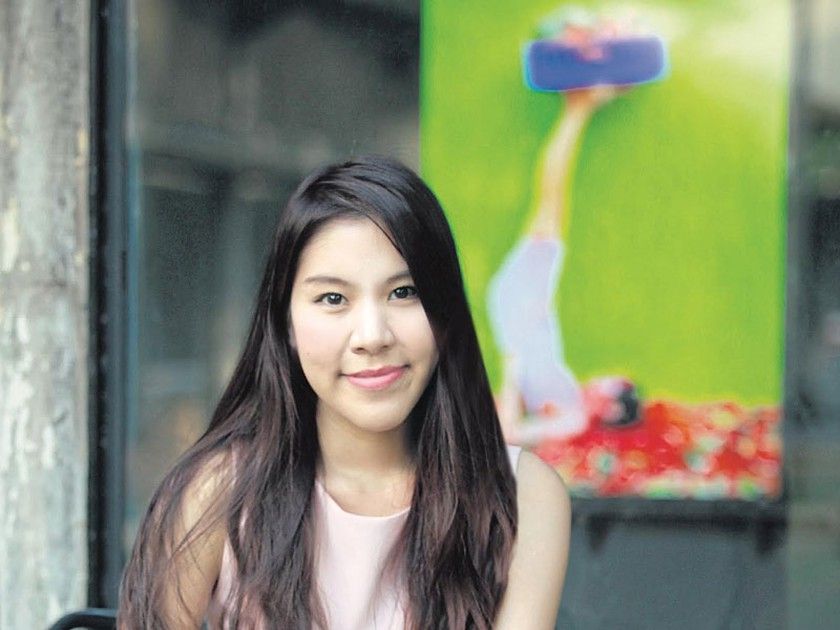Humor to approach serious subjects
by Staff Writer • June 7, 2017

Intense and beautiful, Thai-Australian artist Kawita Vatanajyankur’s three films “The Robes,” “The Scale” and “The Scale of Justice” provide a deep symbolic peek into the role of women in labor.
Located at Main Street Square at 1111 Main St. at Dallas, the film is part of Aurora Picture Show's Sidewalk Cinema installation, project managed by Weingarten Art Group and on view as part of Art Blocks.
Our interview with the artist reveals her thoughtful approach to creating video work.
Q: Why did you use the specific colors seen in your work?
Kawita Vatanajyankur: My work aims to bring attention to female labor in Thailand. In these films, I re-staged the local market where laborers and market sellers use vibrant colors as advertisements to attract visitors.
I would also describe my work as candy-coated. The actions within the work are usually provocative, confronting and hard to watch as they express female and laborers' strength, endurance, resilience and inequality. I feel that the selected bright colors may attract the audience to view the works first before realizing such violence within them. Then, the viewers would be able to fully open their minds and understand the context.
Bright colors also bring humor to the works. I believe that if you are going to say something serious, you might as well make people laugh first.
Q: The physicality of executing your work seems superhuman. What inspired you to explore this type of human expression?
Kawita Vatanajyankur: I was inspired by the Buddha's teaching of meditation. It is a method to release pain, suffering and negativity, to be at present, to let go of my own “sense of self” and view myself from another perspective.
Q: The physicality of executing your work seems superhuman. What inspired you to explore this type of human expression?
Kawita Vatanajyankur: I was inspired by the Buddha's teaching of meditation. It is a method to release pain, suffering and negativity, to be at present, to let go of my own “sense of self” and view myself from another perspective.
In my works, I was transformed entirely into the tools and objects I selected. Through my actions, my strength and my endurance, I turned into the objects both physically and psychologically by convincing myself that I was a part of the object — by losing a sense of self and belonging, by pushing the limits further. I call this method my meditative act.
In my works, I always tend to use meditation postures in order to remove pain and negativity, to remove myself from human limits. I believe that by losing our sense of self, we may find greater strength as though our limits as human beings no longer existed.
Q: What do you hope the viewer will glean from seeing your work?
Q: What do you hope the viewer will glean from seeing your work?
Kawita Vatanajyankur: By exhibiting across Asia, Europe, Australia and the U.S., I have had varieties of reactions toward my work, which is important to me as an artist.
The interpretations and reactions are different depending on the experiences the viewers might have had and their respective societies and cultures. For example, when exhibiting my works in Japan, the audience would speak to me about their hard and repetitive work, stress, how their standards of work are high, and that others never value and appreciate their work enough.
This made me realize that we are all required to work to make a living. We live in a world where work and job positions define us. Some viewers in Asia and South America would see my work as feminist, a voice for gender equality, an expression of female's endurance and strength, a reflection of what females feel in contemporary society and their expectations. Some viewers see my work as a meditative stage to hold on less tightly to ourselves and to let go.
All of these reactions are in fact the true meanings of my work.
Q: What were some challenges in producing the footage for your piece?
Q: What were some challenges in producing the footage for your piece?
Kawita Vatanajyankur: The challenge is that I need to truly convince myself and meditate long enough to let go of my fear, my pain and my limits. I needed to focus and balance myself in order to go through the performance pieces. My body needed to adjust, and my mind needed to accept the force of the situation. I had to let go.
Q: Talk about vertical video: Why did you decide to explore this format?
Kawita Vatanajyankur: In fact, all formats are important to me as long as they can express the message I am trying to say, as long as they can express the actions. Vertical videos allow audiences to see my whole body as well as the risk I had to experience as they would be able to see the height of the spaces.
Mentioned in this Post
Sidewalk Cinema
1111 Main St